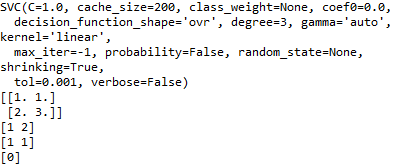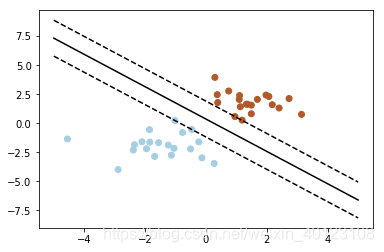sklearn实现svm
from sklearn import svm#导出svm
x = [[2, 0], [1, 1], [2, 3]]#数据
y = [0, 0, 1]#标签
clf = svm.SVC(kernel = 'linear')#实例化
clf.fit(x, y)#拟合
print (clf)
# get support vectors
print (clf.support_vectors_)
# get indices of support vectors
print (clf.support_)
# get number of support vectors for each class
print (clf.n_support_)
print (clf.predict([[2,0]]))

拟合多个点,并得到超平面
import numpy as np
import pylab as pl
from sklearn import svm
np.random.seed(0)
# we create 40 separable points
X = np.r_[np.random.randn(20, 2) - [2, 2], np.random.randn(20, 2) + [2, 2]]
Y = [0]*20 +[1]*20
#fit the model
clf = svm.SVC(kernel='linear')
clf.fit(X, Y)
# get the separating hyperplane
w = clf.coef_[0]
a = -w[0]/w[1]
xx = np.linspace(-5, 5)
yy = a*xx - (clf.intercept_[0])/w[1]
# plot the parallels to the separating hyperplane that pass through the support vectors
b = clf.support_vectors_[0]
yy_down = a*xx + (b[1] - a*b[0])
b = clf.support_vectors_[-1]
yy_up = a*xx + (b[1] - a*b[0])
print ("w: ", w)
print ("a: ", a)
# print "xx: ", xx
# print "yy: ", yy
print ("support_vectors_: ", clf.support_vectors_)
print ("clf.coef_: ", clf.coef_)
# switching to the generic n-dimensional parameterization of the hyperplan to the 2D-specific equation
# of a line y=a.x +b: the generic w_0x + w_1y +w_3=0 can be rewritten y = -(w_0/w_1) x + (w_3/w_1)
# plot the line, the points, and the nearest vectors to the plane
pl.plot(xx, yy, 'k-')
pl.plot(xx, yy_down, 'k--')
pl.plot(xx, yy_up, 'k--')
pl.scatter(clf.support_vectors_[:, 0], clf.support_vectors_[:, 1],
s=80, facecolors='none')
pl.scatter(X[:, 0], X[:, 1], c=Y, cmap=pl.cm.Paired)
pl.axis('tight')
pl.show()

